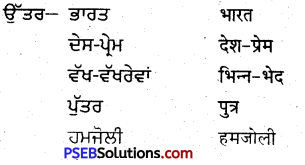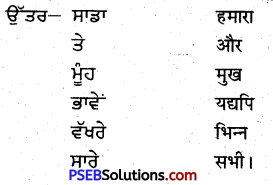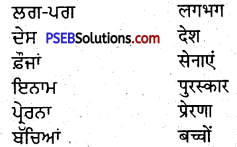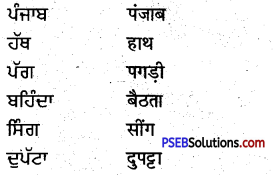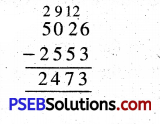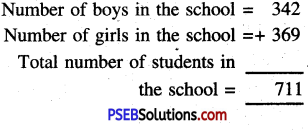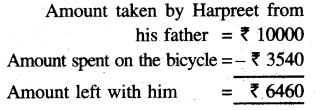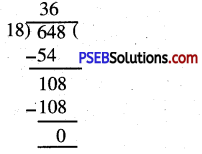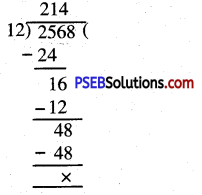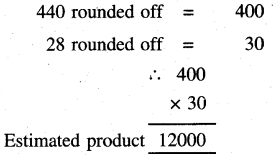Punjab State Board PSEB 5th Class Punjabi Book Solutions Chapter 2 ਆਣਿਆਂ ਦੀ ਰਾਖੀ Textbook Exercise Questions and Answers.
PSEB Solutions for Class 5 Punjabi Chapter 2 ਆਣਿਆਂ ਦੀ ਰਾਖੀ
1. ਖ਼ਾਲੀ ਸਥਾਨ ਭਰੋ:-
ਪ੍ਰਸ਼ਨ-ਖ਼ਾਲੀ ਸਥਾਨ ਭਰੋ-
(ਉ) ਹੈਰੀ ਦੇ ਘਰ ਦੇ ਲਾਗੇ ਦਰਖ਼ਤਾਂ ਦਾ ਇੱਕ ……….. ਸੀ ।
(ਅ) ਕੁਦਰਤ ਦੀ ਗੋਦੀ ਦਾ ………… ਮਾਣੋ
(ੲ) ਇਸ ਅਖਾਉਤ ਅਨੁਸਾਰ ਸਭ ਤੋਂ ਪਹਿਲਾਂ ਤਾਂ ਤੂੰ ਆਪਣੀ ………. ਦਾ ਹੀ ਨੁਕਸਾਨ ਕਰ ਰਿਹੈਂ ।
(ਸ) ਜਾਮਣ ’ਤੇ ਕਈ ਪੰਛੀਆਂ ਨੇ ……….. ਪਾਏ ਹੋਏ ਸਨ ।
(ਹ) ਕੁੱਝ …………… ਨੇ ਬੱਚਿਆਂ ਕੋਲ ਆ ਕੇ ਚੀਂ-ਚੀਂ ਕੀਤੀ ।
(ਕ) ਮੈਂ ਕੁੱਝ ਰੁੱਖ ਵੱਢ ਕੇ ……. ਵੇਚਣੀ ਹੈ ।
ਉੱਤਰ
(ਉ) ਝੰਡ,
(ਅ) ਨਿੱਘ,
(ੲ) ਸਿਹਤ,
(ਸ) ਆਲਣੇ,
(ਹ) ਪੰਛੀਆਂ,
(ਕ) ਲੱਕੜ ।
2. ਸੰਖੇਪ ਵਿੱਚ ਉੱਤਰ ਦਿਓ:-
ਪ੍ਰਸ਼ਨ 1.
ਹੈਰੀ ਦੀਆਂ ਅੱਖਾਂ ਵਿੱਚ ਰੜਕ, ਕਿਉਂ ਪੈਣ ਲੱਗ ਪਈ ਸੀ ?
ਉੱਤਰ:
ਟੀ.ਵੀ. ਦੇਖਣ ਕਾਰਨ
![]()
ਪ੍ਰਸ਼ਨ 2.
ਹੈਰੀ ਦੇ ਘਰ ਦੇ · ਚੜ੍ਹਦੇ ਪਾਸੇ ਵੱਲ ਕਿਹੜੀਆਂ ਪਹਾੜੀਆਂ ਸਨ ?
ਉੱਤਰ:
ਸ਼ਿਵਾਲਿਕ ਦੀਆਂ ਪਹਾੜੀਆਂ ।
ਪ੍ਰਸ਼ਨ 3.
ਬਾਗ ਵਿੱਚ ਜਾ ਕੇ ਬੱਚੇ ਕਿਹੜੀ ਗੱਲ ਭੁੱਲ ਗਏ ?
ਉੱਤਰ:
ਟੀ.ਵੀ. ਦੇਖਣਾ !
ਪ੍ਰਸ਼ਨ 4.
ਹੈਰੀ ਦੇ ਮਾਮਾ ਜੀ ਕੀ ਕੰਮ ਕਰਦੇ ਸਨ ?
ਉੱਤਰ:
ਡਾਕਟਰੀ ।
ਪ੍ਰਸ਼ਨ 5.
ਕਿਸ ਨੂੰ ਵੇਖ ਕੇ ਬੱਚਿਆਂ ਦਾ ਦਿਲ ਉਡਾਰੀ ਮਾਰਨ ਨੂੰ ਕੀਤਾ ?
ਉੱਤਰ:
ਪੰਛੀਆਂ ਨੂੰ ।
3. ਉੱਤਰ ਦਿਓ:
ਪ੍ਰਸ਼ਨ 1.
ਇਸ ਕਹਾਣੀ ਅਨੁਸਾਰ ਭਾਗਾਂ ਵਾਲਾ ਕੌਣ ਹੁੰਦਾ ਹੈ ?
ਉੱਤਰ:
ਭਾਗਾਂ ਵਾਲਾ ਉਹ ਹੁੰਦਾ ਹੈ, ਜਿਸ ਕੋਲ ਕੁਦਰਤ ਦਾ ਸਰਮਾਇਆ ਹੋਵੇ ।
ਪ੍ਰਸ਼ਨ 2.
ਕੁਦਰਤ ਦੇ ਨੇੜੇ ਰਹਿਣ ਨਾਲ ਕਿਸ ਨੂੰ ਬਲ ਮਿਲਦਾ ਹੈ ?
ਉੱਤਰ:
ਕੁਦਰਤ ਦੇ ਨੇੜੇ ਰਹਿਣ ਨਾਲ ਮਨ ਤੇ ਬੁੱਧੀ ਨੂੰ ਬਲ ਮਿਲਦਾ ਹੈ ।
ਪ੍ਰਸ਼ਨ 3.
ਹੈਰੀ ਨੇ ਆਪਣੇ ਮਾਮਾ ਜੀ ਦੀ ਕਿਹੜੀ ” ਗੱਲ ਮੰਨ ਲਈ ?
ਉੱਤਰ:
ਹੈਰੀ ਨੇ ਮਾਮਾ ਜੀ ਦੀ ਇਹ ਗੱਲ ਮੰਨ ਲਈ ਕਿ ਉਸਨੂੰ ਸਾਰਾ ਦਿਨ ਟੀ.ਵੀ. ਨੂੰ ਚਿੰਬੜਿਆ ਰਹਿਣ ਦੀ ਥਾਂ ਬਾਹਰ ਜਾ ਕੇ ਆਲੇ-ਦੁਆਲੇ ਦੇ ਕੁਦਰਤੀ ਨਜ਼ਾਰਿਆਂ ਦਾ ਆਨੰਦ ਲੈਣਾ ਚਾਹੀਦਾ ਹੈ ।
ਪ੍ਰਸ਼ਨ 4.
ਬੱਚੇ ਕਿਉਂ ਦੁਖੀ ਹੋਏ ?
ਉੱਤਰ:
ਜਦੋਂ ਬੱਚਿਆਂ ਨੇ ਦੇਖਿਆ ਕਿ ਪੰਛੀ ਆਪਣੇ ਬਸੇਰੇ ਦਰਖ਼ਤ ਨੂੰ ਵੱਢ ਹੁੰਦਾ ਦੇਖ ਕੇ ਪਰੇਸ਼ਾਨ ਹਨ, ਤਾਂ ਉਹ ਬਹੁਤ ਦੁਖੀ ਹੋਏ ।
![]()
ਪ੍ਰਸ਼ਨ 5.
ਹੈਰੀ ਨੇ ਆਣਿਆਂ ਦੀ ਰਾਖੀ ਕਿਵੇਂ ਕੀਤੀ ?
ਉੱਤਰ:
ਹੈਰੀ ਨੇ ਤਾਇਆ ਜੀ ਨੂੰ ਉਨ੍ਹਾਂ ਦੀ ਲੋੜ ਪੂਰੀ ਕਰਨ ਲਈ ਪੈਸੇ ਆਪਣੇ ਪਿਤਾ ਜੀ ਤੋਂ ਦੁਆਂ ਦਿੱਤੇ ਤੇ ਇਸ ਤਰ੍ਹਾਂ ਉਨ੍ਹਾਂ ਨੂੰ ਦਰੱਖ਼ਤ ਵੱਢਣ ਤੋਂ ਰੋਕ ਕੇ ਪੰਛੀਆਂ ਦੇ ਆਲ੍ਹਣਿਆਂ ਦੀ ਰਾਖੀ ਕੀਤੀ ।
4. ਹੇਠ ਲਿਖੇ ਪੰਜਾਬੀ ਸ਼ਬਦਾਂ ਨੂੰ ਹਿੰਦੀ ਵਿੱਚ ਲਿਖੋ-
ਪ੍ਰਸ਼ਨ 1.
ਹੇਠ ਲਿਖੇ ਪੰਜਾਬੀ ਸ਼ਬਦਾਂ ਨੂੰ ਹਿੰਦੀ ਵਿੱਚ ਲਿਖੋ-
ਆਣਾ, ਨਜ਼ਾਰੇ, ਜੰਗਲ, ਪੰਛੀ, ਪੁੱਟਣਾ, ਕੁਹਾੜੀ !
ਉੱਤਰ:
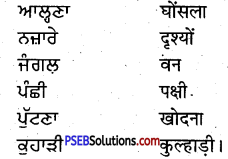
ਪ੍ਰਸ਼ਨ 2.
ਹੇਠ ਲਿਖੇ ਸ਼ਬਦਾਂ/ਮੁਹਾਵਰਿਆਂ ਦੀ ਵਾਕਾਂ ਵਿਚ ਵਰਤੋਂ ਕਰੋ-
ਛਾਂਦਾਰ, ਨਜ਼ਾਰੇ, ਮਾਨਸਿਕ, ਮਸਤ, ਕਮਾਲ, ਕਲਾਵਾ।
ਉੱਤਰ:
- ਛਾਂਦਾਰ ਛਾਂ ਦੇਣ ਵਾਲਾ)-ਪਿੱਪਲ ਬੜਾ ਛਾਂਦਾਰ ਰੁੱਖ ਹੈ ।
- ਨਜ਼ਾਰੇ ਦ੍ਰਿਸ਼, ਮਜ਼ੇ-ਅਸੀਂ ਕੁੱਲੂ-ਮਨਾਲੀ ਜਾ ਕੇ ਪਹਾੜੀ ਦ੍ਰਿਸ਼ਾਂ ਦੇ ਬਹੁਤ ਨਜ਼ਾਰੇ ਲਏ ।
- ਮਾਨਸਿਕ (ਮਨ ਦੀ)-ਖੁਸ਼ ਰਹਿਣਾ ਮਾਨਸਿਕ ਤੰਦਰੁਸਤੀ ਲਈ ਬਹੁਤ ਜ਼ਰੂਰੀ ਹੈ ।
- ਮਸਤ ਨਸ਼ੇ ਵਿੱਚ, ਆਲਾ-ਦੁਆਲਾ ਭੁੱਲਣਾ)ਅਸੀਂ ਸੁੰਦਰ ਪਹਾੜੀ ਦ੍ਰਿਸ਼ ਦੇਖ ਕੇ ਮਸਤ ਹੋ ਗਏ ।
- ਕਮਾਲ ਪੂਰਨ, ਹੈਰਾਨ ਕਰਨ ਵਾਲਾ ਕੰਮਬਈ ! ਕਮਾਲ ਕਰ ਦਿੱਤੀ ਤੂੰ ! ਮੈਨੂੰ ਤਾਂ ਉਮੀਦ ਨਹੀਂ ਸੀ ਕਿ ਤੂੰ ਇਮਤਿਹਾਨ ਵਿਚੋਂ ਸਾਰੀ ਜਮਾਤ ਵਿਚੋਂ ਫ਼ਸਟ ਰਹੇਂਗਾ ।
- ਲੁੱਡੀਆਂ ਪਾਉਣਾ (ਖ਼ੁਸ਼ੀ ਵਿਚ ਨੱਚਣਾ-ਟੱਪਣਾ· ਸਾਡੀ ਹਾਕੀ ਟੀਮ ਦੇ ਸਾਰੇ ਖਿਡਾਰੀ ਪਾਕਿਸਤਾਨ ਵਿਰੁੱਧ ਮੈਚ ਜਿੱਤ ਕੇ ਲੁੱਡੀਆਂ ਪਾਉਣ ਲੱਗ ਪਏ।
- ਕਲਾਵਾ ਦੋਹਾਂ ਬਾਂਹਾਂ. ਵਿਚ ਲੈਣਾ)-ਮਾਂ ਨੇ ਪੁੱਤਰ ਨੂੰ ਕਲਾਵੇ ਵਿਚ ਲੈ ਕੇ ਪਿਆਰ ਕੀਤਾ ।
5. ਪੈਰਿਆਂ ਸੰਬੰਧੀ ਪ੍ਰਸ਼ਨ
1. ਹੇਨ ਲਿਖੇ ਪੈਰ ਨੂੰ ਪੜ੍ਹ ਕੇ ਅੱਗੇ ਦਿੱਤੇ ਪ੍ਰਸ਼ਨਾਂ ਦੇ ਉੱਤਰ ਦਿਓ-
ਹੈਰੀ ਦੇ ਘਰ ਲਾਗੇ ਦਰੱਖ਼ਤਾਂ ਦਾ ਇਕ ਝੁੰਡ ਸੀ, ਜਿਸ ਵਿਚ ਫਲਦਾਰ ਅਤੇ ਛਾਂਦਾਰ ਰੁੱਖ ਲੱਗੇ ਹੋਏ ਸਨ । ਉਹ ਸਾਰਾ ਦਿਨ ਟੀ. ਵੀ. ਦੇਖਦਾ ਰਹਿੰਦਾ ਸੀ ਜਿਸ ਕਾਰਨ ਉਸ ਦੀਆਂ ਅੱਖਾਂ ਵਿਚ ਰੜਕ ਪੈਣ ਲੱਗ ਪਈ । ਇਕ ਦਿਨ ਉਸ ਦੇ ਡਾਕਟਰ ਮਾਮਾ ਜੀ ਆਏ ਤਾਂ ਉਨ੍ਹਾਂ ਨੇ ਹੈਰੀ ਨੂੰ ਸਮਝਾਇਆ, “ਬੇਟੇ ! ਦੇਖ, ਨੀਮ ਪਹਾੜੀ ਇਲਾਕੇ ਵਿਚ ਰਹਿਣ ਦੀਆਂ ਤੈਨੂੰ ਕਿੰਨੀਆਂ ਮੌਜਾਂ ਨੇ ! ਆਲੇ-ਦੁਆਲੇ ਕਿੰਨੇ ਸੋਹਣੇ ਨਜ਼ਾਰੇ ਹਨ । ਚੜ੍ਹਦੇ ਪਾਸੇ ਸ਼ਿਵਾਲਿਕ ਦੀਆਂ ਪਹਾੜੀਆਂ, ਇਧਰ ਬਾਗ਼ ਤੇ ਦੂਜੇ ਪਾਸੇ ਵਿਸ਼ਾਲ ਮੈਦਾਨ ਤੂੰ ਫਿਰ ਵੀ ਟੀ. ਵੀ. ਨਾਲ ਚਿੰਬੜਿਆ ਰਹਿਨੈਂ।”
ਮੈਂ ਇਨ੍ਹਾਂ ਦਾ ਕੀ ਕਰਾਂ ? ਹੈਰੀ ਨੇ ਪੁੱਛਿਆ । ਹਾਂ ਬੇਟਾ, ਸ਼ਾਇਦ ਤੈਨੂੰ ਇਹ ਨੀਂ ਪਤਾ ਕਿ ਸਾਨੂੰ ਇਨ੍ਹਾਂ ਦਾ ਕੀ ਲਾਭ ਹੈ । ਦੂਰ-ਦੁਰਾਡੇ ਵਸਦੇ ਲੋਕ ਕੁਦਰਤੀ ਨਜ਼ਾਰੇ ਦੇਖਣ ਲਈ ਕਿੰਨਾ ਸਫ਼ਰ ਕਰਦੇ ਨੇ । ਹਾਂ ਮਾਮਾ ਜੀ, ਉਨ੍ਹਾਂ ਨੂੰ ਤਾਂ ਬਹੁਤ ਲੰਮਾ ਸਫ਼ਰ ਕਰਨਾ ਪੈਂਦਾ ਹੋਵੇਗਾ, ਕੁੱਲੂ ਤੇ ਮਨਾਲੀ ਜਾਣ ਨੂੰ, ਹੈਰੀ ਨੇ ਜਵਾਬ ਦਿੱਤਾ ।
ਪ੍ਰਸ਼ਨ 1.
ਹਨੀ ਦੇ ਘਰ ਲਾਗੇ ਕੀ ਸੀ ?
ਉੱਤਰ:
ਦਰੱਖ਼ਤਾਂ ਦਾ ਝੰਡ ।
ਪ੍ਰਸ਼ਨ 2.
ਹੈਰੀ ਦੇ ਘਰ ਲਾਗੇ ਦਰੱਖ਼ਤਾਂ ਦੇ ਝੁੰਡ ਕਿਹੋ ਜਿਹੇ ਦਰੱਖਤ ਸਨ ?
ਉੱਤਰ:
ਫਲਦਾਰ ਅਤੇ ਛਾਂਦਾਰ ।
![]()
ਪ੍ਰਸ਼ਨ 3.
ਹੈਰੀ ਸਾਰਾ ਦਿਨ ਕੀ ਕਰਦਾ ਰਹਿੰਦਾ ਸੀ ?
ਉੱਤਰ:
ਟੀ.ਵੀ. ਦੇਖਦਾ ਰਹਿੰਦਾ ਸੀ ।
ਪ੍ਰਸ਼ਨ 4.
ਹੈਰੀ ਦੀਆਂ ਅੱਖਾਂ ਵਿਚ ਰੜਕ ਕਿਉਂ ਪੈਣ ਲੱਗ ਪਈ ਸੀ ?
ਉੱਤਰ:
ਸਾਰਾ ਦਿਨ ਟੀ.ਵੀ. ਦੇਖਦਾ ਰਹਿਣ ਕਰਕੇ ।
ਪ੍ਰਸ਼ਨ 5.
ਹੈਰੀ ਦੇ ਘਰ ਕੌਣ ਆਇਆ ਹੋਇਆ ਸੀ ?
ਉੱਤਰ:
ਉਸਦੇ ਡਾਕਟਰ ਮਾਮਾ ਜੀ ।
ਪਸ਼ਨ 6.
ਹੈਰੀ ਦੇ ਮਾਮਾ ਜੀ ਨੇ ਉਸਨੂੰ ਕੀ ਸਮਝਾਇਆ ?
ਉੱਤਰ:
ਕਿ ਉਹ ਆਪਣੇ ਨੀਮ ਪਹਾੜੀ ਇਲਾਕੇ ਦੇ ਆਲੇ-ਦੁਆਲੇ ਦੇ ਸੋਹਣੇ ਨਜ਼ਾਰਿਆਂ ਦਾ ਅਨੰਦ ਲੈਣ ਦੀ ਥਾਂ ਸਾਰਾ ਦਿਨ ਟੀ.ਵੀ. ਨੂੰ ਚਿੰਬੜਿਆ ਰਹਿੰਦਾ ਹੈ, ਜੋ ਕਿ ਠੀਕ ਨਹੀਂ ।
ਪ੍ਰਸ਼ਨ 7.
ਕਿੱਥੇ ਜਾਣ ਲਈ ਲੋਕਾਂ ਨੂੰ ਬਹੁਤ ਸਫ਼ਰ ਕਰਨਾ ਪੈਂਦਾ ਹੈ ?
ਉੱਤਰ:
ਕੁੱਲੂ ਤੇ ਮਨਾਲੀ ਨੂੰ ।
2. ਹੇਠ ਦਿੱਤੇ ਪੈਰੇ ਨੂੰ ਪੜ੍ਹ ਕੇ ਅੱਗੇ ਲਿਖੇ ਪ੍ਰਸ਼ਨਾਂ ਦੇ ਉੱਤਰ ਦਿਓ-
ਮਾਮਾ ਜੀ ਏਨੀਆਂ ਗੱਲਾਂ ਕਰਕੇ ਦੂਸਰੇ ਕਮਰੇ ਵਿਚ ਹੈਰੀ ਦੇ ਪਾਪਾ ਜੀ ਨਾਲ ਗੱਲਾਂ ਵਿਚ ਮਸਤ ਹੋ ਗਏ । ਹੈਰੀ ਨੇ ਮਾਮਾ ਜੀ ਦੀਆਂ ਗੱਲਾਂ ਤੋਂ ਪ੍ਰਭਾਵਿਤ ਹੋ ਕੇ ਬਾਹਰ ਬਾਗ਼ ਵਿਚ ਜਾਣ ਦਾ ਮਨ ਬਣਾ ਲਿਆ । ਉਸ ਦੇ ਸਾਥੀ ਪ੍ਰਿਅੰਕਾ, ਨੈਨਸੀ, ਸੁਰਖ਼ਾਬ, ਤਨੂੰ, ਬੱਬੂ ਤੇ ਪ੍ਰਿੰਸ ਵੀ ਨਾਲ ਸਨ । ਉਨ੍ਹਾਂ ਨੂੰ ਬਾਗ਼ ਵਿਚ ਘੁੰਮਣ ਨਾਲ ਬੜਾ ਆਨੰਦ ਮਿਲਿਆ । ਕਿਤੇ ਅੰਬਾਂ ਨਾਲ ਲੱਦੇ ਬੂਟੇ, ਕਿਤੇ ਜਾਮਣਾਂ ਦੀ ਠੰਢੀ ਛਾਂ ! ਸਾਰੇ ਬਾਗ਼ ਵਿਚ ਹਰਿਆਲੀ ਅਤੇ ਏ.ਸੀ. ਵਾਲੀ ਠੰਢਕ ਮਹਿਸੂਸ ਕਰ ਕੇ ਬੱਚੇ ਟੀ. ਵੀ. ਦੇਖਣਾ ਵੀ ਭੁੱਲ ਗਏ – ਸਨ ਬਾਗ਼ ਵਿਚ ਉਨ੍ਹਾਂ ਦੇਖਿਆ ਕਿ ਇਕ ਕਿਨਾਰੇ ਲੱਗੀ. : ਜਾਮਣ ’ਤੇ ਕਈ ਪੰਛੀਆਂ ਨੇ ਆਲ੍ਹਣੇ ਪਾਏ ਹੋਏ ਨੇ । ਦੂ ਪੰਛੀ ਆਪਣੀ ਮਸਤੀ ਵਿਚ ਗੀਤ ਗਾ ਰਹੇ ਸਨ । ਜਦੋਂ ਉਨ੍ਹਾਂ
ਬਾਗ਼ ਵਿਚ ਏਨੇ ਪੰਛੀ ਘੁੰਮਦੇ ਦੇਖੇ, ਤਾਂ ਉਨ੍ਹਾਂ ਦੀ ਆਮਦ ਦੀ ਖੁਸ਼ੀ ਵਿਚ ਸਾਰੇ ਗੀਤ ਗਾਉਣ ਲੱਗ ਪਏ । ਹੈਰੀ ਹੋਰੀਂ ਵੀ ਉਨ੍ਹਾਂ ਦੇ ਗੀਤ ਸੁਣ ਕੇ ਲੁੱਡੀਆਂ ਪਾਉਣ ਲੱਗੇ । ਤਰ੍ਹਾਂ-ਤਰ੍ਹਾਂ ਦੇ ਖੰਭਾਂ ਵਾਲੇ ਪੰਛੀ ਜਦੋਂ ਉਨ੍ਹਾਂ ਕੋਲੋਂ ਉਡਾਰੀ ਮਾਰਦੇ, ਤਾਂ ਬੱਚਿਆਂ ਦੇ ਮਨਾਂ ਵਿਚ ਵੀ ਉਨ੍ਹਾਂ ਵਾਂਗ ਉਡਾਰੀਆਂ ਮਾਰਨ ਨੂੰ ਜੀਅ ਕਰਦਾ । ਇਹ ਸਾਰਾ ਦਿਨ ਉੱਥੇ ਹੀ ਘੁੰਮਦੇ ਰਹੇ । ਜਦੋਂ ਘਰ ਵਾਪਸ ਆਏ, ਤਾਂ ਉਨ੍ਹਾਂ ਦੇ ਮਾਤਾ ਜੀ ਨੇ ਪੁੱਛਿਆ, “ਬਈ, ਅੱਜ ਕਿਧਰ ਰਹੇ ?”
ਪ੍ਰਸ਼ਨ 1.
ਮਾਮਾ ਜੀ ਕਿਸ ਨਾਲ ਗੱਲਾਂ ਕਰਨ ਵਿਚ ਮਸਤ ਹੋ ਗਏ ?
ਉੱਤਰ:
ਹੈਰੀ ਦੇ ਪਾਪਾ ਜੀ ਨਾਲ ।
ਪ੍ਰਸ਼ਨ 2.
ਹੈਰੀ ਨੇ ਮਾਮਾ ਜੀ ਦੀਆਂ ਗੱਲਾਂ ਤੋਂ ਪ੍ਰਭਾਵਿਤ ਹੋ ਕੇ ਕੀ ਕੀਤਾ ?
ਉੱਤਰ:
ਉਸਨੇ ਬਾਹਰ ਬਾਗ਼ ਵਿਚ ਜਾਣ ਦਾ ਮਨ ਬਣਾ ਲਿਆ ।
ਪ੍ਰਸ਼ਨ 3.
ਹੈਰੀ ਦੇ ਨਾਲ ਬਾਗ਼ ਵਿਚ ਹੋਰ ਕੌਣ-ਕੌਣ ਸਨ ?
ਉੱਤਰ:
ਪ੍ਰਿਅੰਕਾ, ਨੈਨਸੀ, ਸੁਰਖ਼ਾਬ, ਤਨੂੰ, ਬੱਬੂ ਤੇ ਪਿੰਸ ।
ਪ੍ਰਸ਼ਨ 4.
ਹੈਰੀ ਤੇ ਉਸਦੇ ਸਾਥੀਆਂ ਨੇ ਬਾਗ਼ ਵਿਚ ਕਿਨ੍ਹਾਂ ਚੀਜ਼ਾਂ ਦਾ ਆਨੰਦ ਲਿਆ ?
ਉੱਤਰ:
ਹੈਰੀ ਤੇ ਉਸਦੇ ਸਾਥੀਆਂ ਨੇ ਬਾਗ਼ ਵਿਚ ਅੰਬਾਂ ਨਾਲ ਲੱਦੇ ਬੂਟਿਆਂ, ਜਾਮਣਾਂ ਦੀ ਠੰਢੀ ਛਾਂ, ਸਾਰੇ ਬਾਗ਼ ਦੀ ਹਰਿਆਵਲ ਤੇ ਠੰਢਕ ਦਾ ਆਨੰਦ ਲਿਆ ।’
ਪ੍ਰਸ਼ਨ 5.
ਪੰਛੀਆਂ ਨੇ ਜਿੱਥੇ ਆਲ੍ਹਣੇ ਪਾਏ ਹੋਏ ਸਨ ?
ਉੱਤਰ:
ਜਾਮਣ ਦੇ ਇੱਕ ਰੁੱਖ ਉੱਤੇ ।
ਪ੍ਰਸ਼ਨ 6.
ਬਾਗ਼ ਵਿਚ ਕੌਣ ਕਿਨ੍ਹਾਂ ਦੀ ਆਮਦ ਦੀ ਖ਼ੁਸ਼ੀ ਵਿਚ ਗੀਤ ਗਾਉਣ ਲੱਗ ਪਏ ?
ਉੱਤਰ:
ਬਾਗ਼ ਵਿਚ ਪੰਛੀ ਹੈਰੀ ਤੇ ਉਸਦੇ ਸਾਥੀਆਂ ਦੇ ਆਉਣ ਦੀ ਖ਼ੁਸ਼ੀ ਵਿਚ ਗੀਤ ਗਾਉਣ ਲੱਗ ਪਏ ।
ਪ੍ਰਸ਼ਨ 7.
ਪੰਛੀਆਂ ਦੇ ਗੀਤ ਸੁਣ ਕੇ ਹੈਰੀ ਹੋਰੀ ਕੀ ਕਰਨ ਲੱਗੇ ?
ਉੱਤਰ:
ਲੁੱਡੀਆਂ ਪਾਉਣ ਲੱਗੇ ।
![]()
ਪ੍ਰਸ਼ਨ 8.
ਮਾਤਾ ਜੀ ਨੇ ਹੈਰੀ ਤੋਂ ਕੀ ਪੁੱਛਿਆ ?
ਉੱਤਰ:
ਕਿ ਉਹ ਅੱਜ ਕਿਧਰ ਰਹੇ ਹਨ ।
3. ਹੇਠ ਲਿਖੇ ਪੈਰੇ ਨੂੰ ਪੜ੍ਹ ਕੇ ਅੱਗੇ ਦਿੱਤੇ ਪ੍ਰਸ਼ਨਾਂ ‘ ਦੇ ਉੱਤਰ ਦਿਓ-
ਪਰ ਇਕ ਦਿਨ ਜਦੋਂ ਹੈਰੀ ਦੀ ਟੋਲੀ ਬਾਗ਼ ਵਿਚ ਪਹੁੰਚੀ, ਤਾਂ ਪੰਛੀਆਂ ਨੇ ਉੱਥੇ ਬੜਾ ਰੌਲਾ ਪਾਇਆ, ਹੋਇਆ ਸੀ ।ਉਹ ਹੈਰਾਨ ਸਨ ਕਿ ਅੱਜ ਪੰਛੀ ਗੀਤ ਨੂੰ ਕਿਉਂ ਨਹੀਂ ਗਾਉਂਦੇ ? ਜਦੋਂ ਉਹ ਬਾਗ਼ ਦੇ ਦੂਜੇ ਕਿਨਾਰੇ ਪਹੁੰਚੇ, ਤਾਂ ਕੁੱਝ ਆਦਮੀ ਜਾਮਣ ਦੇ ਉਸ ਰੁੱਖ ਨੂੰ ਵੱਢਣ ਲਈ ਟੋਇਆ ਪੁੱਟ ਰਹੇ ਸਨ, ਜਿਸ ਉੱਤੇ ਕਿ ਕਈ ਪੰਛੀਆਂ ਨੇ ਆਪਣੇ ਆਲ੍ਹਣੇ ਪਾਏ ਹੋਏ ਸਨ । ਇਸ ਕਰਕੇ ਪੰਛੀ ਅੱਜ ਬਹੁਤ ਰੌਲਾ ਪਾ ਰਹੇ ਸਨ । ਉਨ੍ਹਾਂ ਦੀ ਪੂਰੀ ਬਸਤੀ ਉਸ ਰੁੱਖ ਉੱਤੇ ਆ ਬੈਠੀ ਜਾਪਦੀ ਸੀ।
ਪੰਛੀਆਂ ਨੇ ਬੱਚਿਆਂ ਦੇ ਕੋਲ ਆ ਕੇ ਚੀਂ-ਚੀਂ ਕੀਤੀ, ਜਿਵੇਂ ਉਹ ਬੱਚਿਆਂ ਨੂੰ ਕਹਿ ਰਹੇ ਹੋਣ ਕਿ ਇਨ੍ਹਾਂ ਨੂੰ ਰੋਕੋ । ਦਰੱਖ਼ਤ ਵੱਢ ਹੁੰਦੇ ਦੇਖ ਕੇ ਬੱਚੇ ਬੜੇ ਦੁਖੀ ਹੋਏ । ਉਨ੍ਹਾਂ ਨੇ ਸੋਚਿਆ ਕਿ ਇਨ੍ਹਾਂ ਨੂੰ ਕਿਸੇ ਤਰ੍ਹਾਂ ਰੋਕਿਆ ਜਾਵੇ । ਹੈਰੀ ਨੂੰ ਇਕ ਸਕੀਮ ਸੁੱਝੀ । ਇਹ ਬਾਗ਼ ਉਸ ਦੇ ਤਾਏ ਦਾ ਹੀ ਸੀ, ਇਸ ਲਈ ਉਸ ਨੇ ਆਪਣੇ ਤਾਏ ਨਾਲ ਗੱਲ ਕਰਨੀ ਚਾਹੀ, ਜਿਹੜਾ ਕਿ ਦਰੱਖ਼ਤ ਵਢਵਾ ਰਿਹਾ ਸੀ ।
‘‘ਤਾਇਆ ਜੀ, ਤੁਸੀਂ ਇਨ੍ਹਾਂ ਦਰੱਖ਼ਤਾਂ ਨੂੰ ਕਿਉਂ ਵੱਢ ਰਹੇ ਹੋ ? ਉਸ ਨੇ ਆਪਣੇ ਤਾਏ ਨੂੰ ਪੁੱਛਿਆ । “ਬੇਟਾ, ਮੈਨੂੰ ਥੋੜੇ ਪੈਸੇ ਚਾਹੀਦੇ ਨੇ । ਮੈਂ ਕੁੱਝ ਰੁੱਖ ਵੱਢ ਕੇ ਲੱਕੜ ਵੇਚਣੀ ਹੈ । ਇਸ ਲਈ ਵਢਵਾ ਰਿਹਾਂ ।”
ਪ੍ਰਸ਼ਨ 1.
ਪੰਛੀ ਗੀਤ ਗਾਉਣ ਦੀ ਥਾਂ ਕੀ ਕਰ ਰਹੇ ਹਨ ?
ਉੱਤਰ:
ਉਨ੍ਹਾਂ ਬਹੁਤ ਰੌਲਾ ਪਾਇਆ ਹੋਇਆ ਸੀ ।
ਪ੍ਰਸ਼ਨ 2.
ਬਾਗ਼ ਦੇ ਦੂਜੇ ਕਿਨਾਰੇ ਉੱਤੇ ਕੁੱਝ ਆਦਮੀ ਕੀ ਕਰ ਰਹੇ ਸਨ ?
ਉੱਤਰ:
ਜਾਮਣ ਦੇ ਰੁੱਖ ਨੂੰ ਵੱਢਣ ਲਈ ਟੋਇਆ ਪੁੱਟ ਰਹੇ ਸਨ ?
ਪ੍ਰਸ਼ਨ 3.
ਪੰਛੀਆਂ ਨੇ ਆਲ੍ਹਣੇ ਕਿੱਥੇ ਪਾਏ ਹੋਏ ਸਨ ?
ਉੱਤਰ:
ਉਸ ਰੁੱਖ ਉੱਤੇ, ਜਿਸਨੂੰ ਕੁੱਝ ਆਦਮੀ ਵੱਢਣ ਲਈ ਟੋਇਆ ਪੁੱਟ ਰਹੇ ਸਨ ।
ਪ੍ਰਸ਼ਨ 4.
ਪੰਛੀ ਜਾਮਣ ਨੂੰ ਵੱਢਣ ਦਾ ਵਿਰੋਧ ਕਰਨ ਲਈ ਕੀ ਕਰ ਰਹੇ ਸਨ ?
ਉੱਤਰ:
ਜਾਮਣ ਦੇ ਰੁੱਖ ਨੂੰ ਵੱਢਣ ਦਾ ਵਿਰੋਧ ਕਰਨ ਲਈ ਉਨ੍ਹਾਂ ਪੰਛੀਆਂ ਦੀ ਸਾਰੀ ਬਸਤੀ ਉਸ ਰੁੱਖ ਉੱਤੇ ਬੈਠ ਕੇ ਰੌਲਾ ਪਾ ਰਹੀ ਸੀ ।
ਪ੍ਰਸ਼ਨ 5.
ਪੰਛੀ ਜਾਮਣ ਦੇ ਰੁੱਖ ਨੂੰ ਵੱਢਣ ਦਾ , ਵਿਰੋਧ ਕਿਉਂ ਕਰ ਰਹੇ ਸਨ ?
ਉੱਤਰ:
ਕਿਉਂਕਿ ਜਾਮਣ ਦੇ ਰੁੱਖ ਉੱਤੇ ਉਨ੍ਹਾਂ ਦੇ ਆਲ੍ਹਣੇ ਸਨ ਤੇ ਆਲ੍ਹਣਿਆਂ ਵਿਚ ਉਨ੍ਹਾਂ ਦੇ ਬੱਚੇ ਸਨ ।
ਪ੍ਰਸ਼ਨ 6.
ਬਾਗ ਕਿਸ ਦਾ ਸੀ ?
ਉੱਤਰ:
ਹੈਰੀ ਦੇ ਤਾਏ ਦਾ ।
ਪ੍ਰਸ਼ਨ 7.
ਹੈਰੀ ਦਾ ਤਾਇਆ ਰੁੱਖਾਂ ਨੂੰ ਕਿਉਂ ਵਢਵਾ ਰਿਹਾ ਸੀ ?
ਉੱਤਰ:
ਕਿਉਂਕਿ ਉਸਨੂੰ ਥੋੜ੍ਹੇ ਜਿਹੇ ਪੈਸਿਆਂ ਦੀ ਲੋੜ ਸੀ ।
6. ਬਹੁਵਿਕਲਪੀ ਪ੍ਰਸ਼ਨ ਹੇਠ ਦਿੱਤੇ ਪ੍ਰਸ਼ਨਾਂ ਦੇ ਬਹੁਵਿਕਲਪੀ ਉੱਤਰਾਂ ਵਿੱਚੋਂ ਠੀਕ ਉੱਤਰ ਅੱਗੇ ਸਹੀ (✓) ਦਾ ਨਿਸ਼ਾਨ ਲਾਓ
ਪ੍ਰਸ਼ਨ : 1.
‘ਆਣਿਆਂ ਦੀ ਰਾਖੀ ਕਹਾਣੀ ਦਾ ਲੇਖਕ ਕੌਣ ਹੈ ?
ਉੱਤਰ:
ਬਲਜਿੰਦਰ ਮਾਨ (✓)।
ਪ੍ਰਸ਼ਨ 2.
ਇਹ ਪੈਰਾ ਕਿਸ ਕਹਾਣੀ ਵਿਚੋਂ ਲਿਆ ਗਿਆ ਹੈ ?
ਉੱਤਰ:
ਆਲ੍ਹਣਿਆਂ ਦੀ ਰਾਖੀ (✓) ।
ਪਸ਼ਨ 3.
ਹੈਰੀ ਦੇ ਘਰ ਲਾਗੇ ਕੀ ਸੀ ?
ਉੱਤਰ:
ਦਰੱਖ਼ਤਾਂ ਦੇ ਝੁੰਡ (✓) ।
ਪ੍ਰਸ਼ਨ 4.
ਹੈਰੀ ਸਾਰਾ ਦਿਨ ਕੀ ਦੇਖਦਾ ਰਹਿੰਦਾ ਸੀ ?
ਉੱਤਰ:
ਟੀ.ਵੀ. (✓) ।
ਪ੍ਰਸ਼ਨ 5.
ਕਿਸ ਦੀਆਂ ਅੱਖਾਂ ਵਿਚ ਰੜਕ ਪੈਣ ਲੱਗੀ ਸੀ ?
ਉੱਤਰ:
ਹੈਰੀ ਦੀਆਂ (✓) ।
![]()
ਪ੍ਰਸ਼ਨ 6.
ਹੈਰੀ ਦੇ ਮਾਮਾ ਜੀ ਕੀ ਕੰਮ ਕਰਦੇ ਹਨ ?
ਉੱਤਰ:
ਡਾਕਟਰ (✓) ।
ਪ੍ਰਸ਼ਨ 7.
ਹੈਰੀ ਕਿਸ ਇਲਾਕੇ ਵਿਚ ਰਹਿੰਦਾ ਸੀ ? ਉੱਤਰ-ਨੀਮ-ਪਹਾੜੀ (✓) ।.
ਪ੍ਰਸ਼ਨ 8.
ਹੈਰੀ ਦੇ ਘਰ ਦੇ ਨੇੜੇ ਕਿਹੜੀਆਂ ਪਹਾੜੀਆਂ ਸਨ ?
ਉੱਤਰ:
ਸ਼ਿਵਾਲਕ (✓)।
ਪ੍ਰਸ਼ਨ 9.
ਲੋਕ ਕਿੱਥੋਂ ਦੇ ਕੁਦਰਤੀ ਨਜ਼ਾਰੇ ਦੇਖਣ ਨੂੰ ਲਈ ਲੰਮਾ ਸਫ਼ਰ ਕਰਦੇ ਹਨ ?
ਉੱਤਰ:
ਕੁੱਲੂ ਤੇ ਮਨਾਲੀ (✓)।
ਪ੍ਰਸ਼ਨ 10.
ਡਾਕਟਰ ਮਾਮਾ ਜੀ ਅਨੁਸਾਰ ਕਿਹੜੀ ਚੀਜ਼ ਕੋਲ ਹੋਣ ਕਰਕੇ ਹੈਰੀ ਭਾਗਾਂ ਵਾਲਾ ਸੀ ?
ਉੱਤਰ:
ਕੁਦਰਤੀ ਨਜ਼ਾਰੇ (✓) ।
ਪ੍ਰਸ਼ਨ 11.
ਹੈਰੀ ਦੇ ਪਾਪਾ ਉਸਨੂੰ ਕਿਸ ਦੀ ਗੋਦੀ ਦਾ ਨਿੱਘ ਮਾਣਨ ਲਈ ਕਹਿੰਦੇ ਸਨ ?
ਉੱਤਰ:
ਕੁਦਰਤ ਦੀ (✓)।
ਪ੍ਰਸ਼ਨ 12.
ਸ਼ੁੱਧ ਹਵਾ ਨਾਲ ਸਾਡੇ ਅੰਦਰੋਂ ਕਿਹੜੀ ਚੀਜ਼ ਦੀ ਕਮੀ ਦੂਰ ਹੋ ਜਾਂਦੀ ਹੈ ?
ਜਾਂ
ਕਿਸ ਚੀਜ਼ ਨਾਲ ਸਾਡੀ ਸਰੀਰਕ, ਮਾਨਸਿਕ, ਬੋਧਿਕ ਮਾਸਪੇਸ਼ੀਆਂ ਦੀ ਸਮਰੱਥਾ ਵਧਦੀ ਹੈ ਤੇ ਸਾਡੀ ਸਿਹਤ ਠੀਕ ਰਹਿੰਦੀ ਹੈ ?
ਉੱਤਰ:
ਆਕਸੀਜਨ (✓)
ਪ੍ਰਸ਼ਨ 13.
ਕਿਸ ਦੀਆਂ ਗੱਲਾਂ ਤੋਂ ਪ੍ਰਭਾਵਿਤ ਹੋ ਕੇ ਹੈਰੀ ਨੇ ਬਾਗ਼ ਵਿਚ ਘੁੰਮਣ ਦਾ ਮਨ ਬਣਾ ਲਿਆ ?
ਉੱਤਰ:
ਡਾਕਟਰ ਮਾਮੇ ਦੀਆਂ (✓)।
ਪ੍ਰਸ਼ਨ 14.
ਕਿਸ ਰੁੱਖ ਉੱਤੇ ਪੰਛੀਆਂ ਦੇ ਆਲ੍ਹਣੇ ਸਨ ?
ਉੱਤਰ:
ਜਾਮਣ (✓)
ਪ੍ਰਸ਼ਨ 15.
ਪੰਛੀਆਂ ਨੂੰ ਗੀਤ ਗਾਉਂਦੇ ਸੁਣ ਕੇ ਹੈਰੀ ਤੇ ਉਸਦੇ ਸਾਥੀ ਕੀ ਕਰਨ ਲੱਗੇ ?
ਉੱਤਰ:
ਲੁੱਡੀਆਂ ਪਾਉਣ ਲੱਗੇ (✓) ।
ਪ੍ਰਸ਼ਨ 16.
ਜਾਮਣ ਦਾ ਰੁੱਖ ਵੱਢੇ ਜਾਣ ’ਤੇ ਕੌਣ ਰੌਲਾ ਪਾ ਰਹੇ ਸਨ ?
ਉੱਤਰ:
ਪੰਛੀ (✓)।
![]()
ਪ੍ਰਸ਼ਨ 17.
ਕਿਹੜਾ ਰੁੱਖ ਵੱਢਿਆ ਜਾ ਰਿਹਾ ਸੀ ?
ਉੱਤਰ:
ਜਾਮਣ ਦਾ (✓) ।
ਪ੍ਰਸ਼ਨ 18.
ਬਾਗ ਕਿਸ ਦਾ ਸੀ ?
ਉੱਤਰ:
ਹੈਰੀ ਦੇ ਤਾਏ ਦਾ (✓) ।
ਪ੍ਰਸ਼ਨ 19.
ਹੈਰੀ ਦਾ ਤਾਇਆ ਦਰੱਖ਼ਤ ਕਿਉਂ ਵਢਵਾ ਰਿਹਾ ਸੀ ?
ਉੱਤਰ:
ਪੈਸਿਆਂ ਖ਼ਾਤਰ (✓)।
ਪ੍ਰਸ਼ਨ 20.
ਹੈਰੀ ਨੇ ਕਿਸ ਨੂੰ ਤਾਏ ਦੀ ਪੈਸਿਆਂ ਦੀ ਲੋੜ ਪੂਰੀ ਕਰਨ ਲਈ ਕਿਹਾ ?
ਉੱਤਰ:
ਪਾਪਾ ਨੂੰ (✓)।
ਪ੍ਰਸ਼ਨ 21.
ਹੈਰੀ/ਪ੍ਰਿਅੰਕਾ/ਨੈਨਸੀ/ਸੁਰਖ਼ਾਬ/ਤਨੂੰ ਬੱਬੂ ਤੇ ਪ੍ਰੈਸ ਕਿਸ ਕਹਾਣੀ ਦੇ ਪਾਤਰ ਹਨ ?
ਉੱਤਰ:
ਆਲ੍ਹਣਿਆਂ ਦੀ ਰਾਖੀ (✓)

